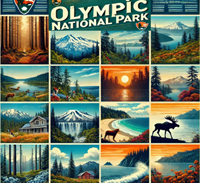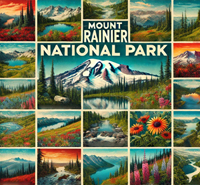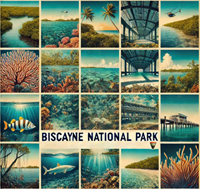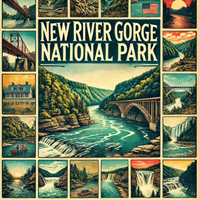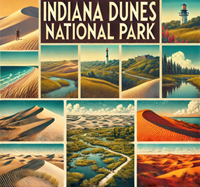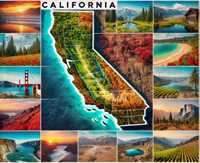

Embark on a journey curated by seasoned explorers William and Hui Cha Stanek, who have spent decades immersing themselves in the diverse landscapes of North America. These itineraries are more than just travel plans - they are thoughtfully crafted adventures designed to help you connect with the natural world, discover hidden gems, and create lasting memories.
National Parks Index | US Itineraries Index | American Roadtrips Index

Bring home a Bugville Critters book and watch as your child's love for reading and learning grows with every page. Hand-painted illustrations bring the heartwarming stories to life. Ask your librarian to add Bugville Critters to the library's digital collection today!
Discover William Stanek's Exclusive Art Collection
Explore and purchase the stunning art featured on this site. Own a piece of William Stanek's unique and captivating artwork today!
(May 2, 2025) Exploring Arches and Canyonlands National Parks
Introduction: A 3-Day Journey Through Time and Stone
It was the late summer of 2005 when Hui Cha and I first ventured into the vast landscapes of Arches and Canyonlands National Parks. We had heard tales of these parks from fellow travelers – stories of surreal stone formations, breathtaking canyons, and the profound silence of the desert. Yet nothing could have prepared us for the reality of standing amidst these ancient giants.
Our journey began in the pre-dawn hours, the kind of early morning when the air is still cool and the world is just beginning to stir. The land around us was cloaked in darkness, but as the first light of day crept over the horizon, it unveiled a world that seemed almost otherworldly. The towering red rock formations of Arches National Park emerged from the shadows, bathed in the soft, golden light of dawn.
For me, William, this trip was a pilgrimage of sorts. As a photographer, I had long dreamed of capturing the ethereal beauty of these parks, of finding that perfect moment when the light, the landscape, and the emotion all come together to create something truly special. For Hui Cha, it was an opportunity to connect with the natural world in a way that felt both grounding and inspiring.
This journey through Arches and Canyonlands was not just about capturing images; it was about experiencing the profound sense of place that these parks offer. They are places where time feels stretched, where the silence of the desert allows for deep reflection, and where the ancient stone formations remind us of the incredible forces that have shaped our world.
In this guide, we will share our detailed itineraries, tips, and personal insights to help you make the most of your own adventure in these stunning parks. Whether you have one day or three, this guide will lead you to the most awe-inspiring locations, provide practical advice on photography, and offer alternatives for those seeking a less strenuous experience.
Day 1: Discovering the Natural Wonders of Arches National Park
Morning: Sunrise at Delicate Arch
5:30 AM - Sunrise at Delicate Arch
Overview: Start your day with a hike to Delicate Arch, the most iconic landmark in Arches National Park. This natural sandstone arch stands alone on a rock face, framed by the La Sal Mountains in the distance. Sunrise is the perfect time to experience this site, as the soft morning light illuminates the arch in a warm glow, creating a magical atmosphere.
Tips from William: "Arrive at least an hour before sunrise to allow time for the hike and to find a good spot to set up your gear. Use a wide-angle lens to capture the entire arch and surrounding landscape, and a polarizing filter to enhance the colors of the sky and rock. Consider bracketing your shots to capture the full dynamic range of light, especially as the sun rises and creates strong contrasts."
Insights from Hui Cha: "This hike can be challenging, especially in the dark, so bring a headlamp and watch your footing on the slickrock. Dress in layers – mornings can be chilly, but you'll warm up quickly on the ascent. A thermos of hot tea or coffee can be a comforting reward at the top."
How to Access Delicate Arch:
- Location: Delicate Arch is located in the eastern section of Arches National Park.
- Travel Directions: From the park entrance, take the Arches Scenic Drive for about 12 miles to the Wolfe Ranch parking area. The trailhead for Delicate Arch starts here.
- Trail Details: The hike to Delicate Arch is 3 miles round-trip with an elevation gain of about 480 feet. The trail includes some steep sections and a final ascent across an exposed rock face, so be prepared for a moderate challenge.
Alternative Activity: Delicate Arch Viewpoint
- For a less strenuous option, consider visiting the Delicate Arch Viewpoint. This short, easy walk offers a distant but still impressive view of the arch without the need for a steep climb.
Photographic Techniques:
- Golden Hour Lighting: The first light of day creates a golden hue that is perfect for capturing the rich red tones of the sandstone. Adjust your white balance to capture the warmth of the scene.
- Framing: Use the natural surroundings to frame the arch – position yourself so that the La Sal Mountains are visible through the arch, adding depth and context to your shot.
- Focus Stacking: If you're using a wide-angle lens, consider focus stacking to ensure that both the foreground and background are sharp. This technique involves taking multiple shots at different focus points and blending them together in post-processing.
Exploring the Area:
- After photographing Delicate Arch, take some time to explore the surrounding area. The trail offers several vantage points that provide different perspectives of the arch and the surrounding landscape. The morning light will continue to change, offering new opportunities for photography as the sun rises higher in the sky.
Midday: Discovering the Windows Section
11:00 AM - The Windows Section
Overview: The Windows Section is one of the most accessible and photogenic areas in Arches National Park. Here, you'll find some of the largest and most spectacular arches in the park, including the North and South Windows and Turret Arch. This area is perfect for both casual visitors and dedicated photographers.
Tips from William: "The midday light can be harsh, so focus on capturing the textures and shapes of the arches. Use a mid-range zoom lens (24-70mm) to play with different compositions, and don't be afraid to experiment with black-and-white photography to emphasize the contrast between the rock and sky."
Insights from Hui Cha: "This area can get busy, especially in the late morning, so be patient and wait for those moments when the crowds thin out. If you're looking for a quieter experience, consider exploring the nearby Double Arch, which is often less crowded but just as impressive."
How to Access the Windows Section:
- Location: The Windows Section is located in the central part of Arches National Park.
- Travel Directions: From Delicate Arch, return to the main road and continue driving for about 5 miles until you see the turnoff for the Windows Section. Follow the signs to the parking area.
- Trail Details: The Windows Loop Trail is an easy 1-mile loop that takes you to the North and South Windows and Turret Arch. The trail is well-maintained and suitable for all fitness levels.
Alternative Activity: Double Arch
- For those who prefer a shorter walk, Double Arch is just a short stroll from the same parking area. This arch is unique in that it consists of two arches that share the same stone foundation.
Photographic Techniques:
- HDR Imaging: The high contrast between the shadows under the arches and the bright sky makes this an ideal location for HDR (High Dynamic Range) photography. Take multiple exposures and combine them in post-processing to capture all the details.
- Textures and Patterns: Focus on the intricate textures of the sandstone, especially in the early afternoon when the light casts deep shadows that highlight the natural patterns in the rock.
- Silhouettes: Consider shooting towards the sun to create dramatic silhouettes of the arches against the sky. This can add a striking and graphic element to your images.
Exploring the Area:
- After exploring the Windows Section, take a short drive to nearby Balanced Rock. This large boulder perched precariously on a sandstone pedestal offers another fantastic photo opportunity and is just a short walk from the parking area.
Afternoon: The Fiery Furnace Tour
2:30 PM - The Fiery Furnace
Overview: The Fiery Furnace is a labyrinth of narrow canyons and towering fins of rock. This area is a true playground for adventurous hikers and photographers, offering a maze-like network of passages to explore. Due to the complexity of the terrain, it's best to join a ranger-guided tour or obtain a permit if you're experienced with navigation.
Tips from William: "This is a place where you can really get creative with your photography. Use a wide-angle lens to capture the tight spaces and towering walls, and don't be afraid to get in close to highlight the textures and details of the rock. The light in the Fiery Furnace is constantly changing as the sun moves overhead, creating opportunities for both high-contrast and soft, diffused light photography."
Insights from Hui Cha: "Navigating the Fiery Furnace can be challenging, so make sure you're prepared. Wear sturdy shoes, bring plenty of water, and be mindful of your surroundings. This is one of the more physically demanding areas of the park, so take your time and enjoy the adventure."
How to Access the Fiery Furnace:
- Location: The Fiery Furnace is located in the central part of Arches National Park, not far from the Windows Section.
- Travel Directions: From the Windows Section, continue driving north on the main road for about 3 miles until you see the turnoff for the Fiery Furnace. The parking area is well-marked.
- Tour Information: Ranger-guided tours are available and highly recommended for those unfamiliar with the area. These tours provide valuable insights into the geology and ecology of the Fiery Furnace, as well as ensuring that you don't get lost in the maze.
Alternative Activity: Sand Dune Arch
- If the Fiery Furnace sounds too intense, consider visiting Sand Dune Arch instead. This short, easy hike takes you to a secluded arch nestled between towering fins of rock. The soft sand underfoot and the cool shade make it a great place to relax and enjoy some quiet time.
Photographic Techniques:
- Play with Light: The narrow canyons of the Fiery Furnace offer a unique opportunity to play with light and shadow. Look for spots where the sun filters through the rock, creating beams of light that add a dramatic effect to your images.
- Abstract Compositions: The intricate patterns and textures of the rock lend themselves well to abstract photography. Focus on small details or unusual angles to create images that are more about form and color than about recognizable subjects.
- Reflections: If you're lucky enough to visit after a rain, look for small puddles that form in the low spots of the rock. These can create beautiful reflections that add a new dimension to your photos.
Exploring the Area:
- After your tour, take some time to explore the nearby Devils Garden area, which offers additional hiking trails and some of the park's most famous arches, including Landscape Arch. The late afternoon light is perfect for photographing these features, and the crowds tend to thin out as the day goes on.
Evening: Sunset at the Garden of Eden
6:30 PM - Garden of Eden
Overview: End your day in Arches National Park with a sunset at the Garden of Eden, a cluster of striking rock formations that glow with a deep red hue as the sun sets. This area is easily accessible and offers a variety of compositions, from wide-angle landscapes to close-ups of the intricate rock formations.
Tips from William: "The Garden of Eden is a great place to experiment with different focal lengths. Use a wide-angle lens to capture the entire scene, and a telephoto lens to zoom in on the details. The golden hour light will bring out the rich colors of the sandstone, so be ready to shoot quickly as the light changes."
Insights from Hui Cha: "This area is often overlooked by visitors, making it a peaceful place to watch the sunset. Bring a light jacket, as the temperature can drop quickly after the sun goes down. It's a perfect spot to reflect on the day and take in the beauty of the park."
How to Access the Garden of Eden:
- Location: The Garden of Eden is located near the entrance of Arches National Park, just a short drive from the main road.
- Travel Directions: From the park entrance, take the Arches Scenic Drive for about 2 miles until you see the turnoff for the Garden of Eden. The parking area is well-marked.
- Trail Details: There are no formal trails in the Garden of Eden, but the area is open for exploration. Be mindful of the fragile desert ecosystem and stay on established paths whenever possible.
Photographic Techniques:
- Silhouettes: As the sun sets, the rock formations can create dramatic silhouettes against the colorful sky. Position yourself so that the sun is just behind the formations to capture this effect.
- Color Contrast: The deep reds of the sandstone contrast beautifully with the blue of the sky during sunset. Use this contrast to create striking images that showcase the unique colors of the desert.
- Foreground Interest: Include some of the desert plants or smaller rock formations in the foreground of your shots to add depth and interest to your compositions.
Exploring the Area:
- After sunset, consider staying a bit longer for some stargazing. The clear desert skies offer excellent conditions for night photography, and the Garden of Eden provides a dramatic foreground for capturing the stars.
Day 2: Immersing in the Rugged Beauty of Canyonlands National Park
Morning: Sunrise at Mesa Arch
5:30 AM - Mesa Arch
Overview: Mesa Arch is one of the most iconic spots in Canyonlands National Park, particularly at sunrise. The arch frames a stunning view of the canyons and distant mountains, with the rising sun casting a warm glow on the underside of the arch, making it appear as if it's glowing from within.
Tips from William: "This is a popular spot, so arrive at least an hour before sunrise to secure your place. Use a wide-angle lens to capture the full scene, and consider using a graduated neutral density filter to balance the exposure between the bright sky and the darker foreground. A small aperture (f/16 or f/22) will help you achieve a starburst effect as the sun rises."
Insights from Hui Cha: "It can get crowded, but the experience is worth it. Dress warmly and bring a thermos of hot tea or coffee. The glow of the arch is breathtaking, and it's one of those moments that stays with you long after you leave."
How to Access Mesa Arch:
- Location: Mesa Arch is located in the Island in the Sky district of Canyonlands National Park.
- Travel Directions: From the park entrance, drive about 6 miles on the main road until you see the turnoff for Mesa Arch. The parking area is well-marked, and the trailhead is nearby.
- Trail Details: The trail to Mesa Arch is a short, easy walk of about 0.5 miles round-trip. The path is well-maintained and suitable for all fitness levels.
Alternative Activity: Grand View Point
- For a less crowded sunrise experience, consider Grand View Point. This overlook offers sweeping views of the canyons and is accessible via a short, easy trail.
Photographic Techniques:
- Starburst Effect: To create a starburst effect as the sun rises, set your aperture to f/16 or smaller. Position yourself so that the sun is just peeking over the horizon or through the arch.
- Foreground and Background: Include the distant mountains and canyons in the background to give context to the arch and create a sense of depth in your composition.
- HDR Imaging: The contrast between the bright sky and the darker foreground makes this an ideal location for HDR photography. Take multiple exposures and blend them in post-processing to capture all the details.
Exploring the Area:
- After photographing Mesa Arch, take some time to explore the Island in the Sky district. The nearby overlooks, such as Green River Overlook and Buck Canyon Overlook, offer stunning views of the canyons and are perfect for mid-morning photography.
Midday: Hiking the White Rim Overlook Trail
11:00 AM - White Rim Overlook Trail
Overview: The White Rim Overlook Trail offers one of the best views in Canyonlands National Park. This easy, 1.8-mile round-trip hike takes you to an overlook with panoramic views of the White Rim, a distinct layer of white rock that forms a stunning contrast against the red canyons below.
Tips from William: "Midday light can be harsh, but the expansive views are worth the hike. Use a polarizing filter to bring out the colors of the rock and sky. A wide-angle lens is ideal for capturing the full sweep of the landscape, but don't forget to bring a telephoto lens to zoom in on the details of the canyons and distant formations."
Insights from Hui Cha: "This is a relatively easy hike, but be sure to bring plenty of water and sun protection. The overlook is a fantastic spot for a picnic, so pack a lunch and take your time enjoying the view."
How to Access the White Rim Overlook Trail:
- Location: The White Rim Overlook Trail is located in the Island in the Sky district, near the Gooseberry and White Rim Overlooks.
- Travel Directions: From Mesa Arch, continue driving south on the main road for about 7 miles until you reach the trailhead parking area. The trailhead is well-marked.
- Trail Details: The trail is an easy 1.8-mile round-trip hike with minimal elevation gain. The path is well-maintained and suitable for hikers of all skill levels.
Alternative Activity: Shafer Trail Overlook
- For a shorter, easier walk, visit the Shafer Trail Overlook. This viewpoint offers impressive views of the winding Shafer Trail Road and the canyons below, with minimal walking required.
Photographic Techniques:
- Panoramic Shots: The wide-open landscape is perfect for panoramic photography. Take multiple shots from left to right and stitch them together in post-processing to create a sweeping vista of the canyons.
- Leading Lines: Use the lines of the White Rim and the winding canyons to lead the viewer's eye into the image and towards the distant horizon.
- Contrast and Texture: The contrast between the white rock of the rim and the red sandstone below creates a striking visual effect. Focus on the textures of the rock to add interest to your compositions.
Exploring the Area:
- After completing the White Rim Overlook Trail, consider exploring the nearby Gooseberry Trail, which offers additional viewpoints and a slightly more challenging hike with similar stunning views.
Afternoon: Exploring the Maze from Above
2:30 PM - The Maze Overlook (Flyover)
Overview: The Maze is the most remote and challenging district of Canyonlands National Park, known for its labyrinthine canyons and rugged terrain. While reaching the Maze by land requires significant planning and a high-clearance vehicle, an aerial tour offers a breathtaking perspective of this stunning landscape without the physical demands.
Tips from William: "If you have the opportunity, an aerial tour of the Maze is an unforgettable experience. From above, you can capture the intricate patterns of the canyons and the vastness of the landscape. Use a fast shutter speed (1/1000 or faster) to ensure sharp images from the moving aircraft, and a polarizing filter to reduce glare from the windows."
Insights from Hui Cha: "An aerial tour provides a unique perspective that you simply can't get from the ground. It's a great way to see the park's most remote areas and capture images that few others have. Be sure to book your tour in advance, as these flights can fill up quickly."
How to Access the Maze Overlook (Flyover):
- Location: Aerial tours typically depart from Moab, Utah, and offer flyovers of both Canyonlands and Arches National Parks.
- Booking Information: Several companies in Moab offer scenic flights over the Maze and other parts of Canyonlands. Tours range from 1-2 hours and can be customized based on your interests.
- Flight Details: Flights are typically conducted in small aircraft, allowing for excellent visibility and the opportunity to capture stunning aerial photographs.
Alternative Activity: Canyonlands Overlook
- If an aerial tour isn't in the cards, consider visiting the Canyonlands Overlook, accessible by a 4WD vehicle. This overlook provides expansive views of the Needles district and the Maze from a high vantage point.
Photographic Techniques:
- Aerial Composition: From the air, focus on the patterns and textures of the landscape. Look for repeating shapes, such as the winding canyons or the layers of rock, to create compelling compositions.
- Vibration Reduction: To counteract the vibrations of the aircraft, use a fast shutter speed and consider increasing your ISO to ensure sharp images.
- Window Glare: To reduce glare from the airplane windows, press your lens as close to the glass as possible and use a polarizing filter.
Exploring the Area:
- After your flight, take some time to relax in Moab. The town offers plenty of dining options and local shops where you can pick up souvenirs or simply enjoy the vibrant atmosphere.
Evening: Sunset at Dead Horse Point State Park
6:30 PM - Dead Horse Point State Park
Overview: While not part of Canyonlands National Park, Dead Horse Point State Park offers one of the most spectacular viewpoints in the region. From the overlook, you can see the Colorado River winding through the canyons below, with the sun setting over the distant horizon. This is a perfect spot to end your day, with panoramic views that are second to none.
Tips from William: "Arrive at least an hour before sunset to find a good spot and set up your gear. Use a wide-angle lens to capture the sweeping views, and a graduated neutral density filter to balance the exposure between the bright sky and the darker canyon below. As the sun sets, keep shooting to capture the changing colors of the sky and the deepening shadows in the canyon."
Insights from Hui Cha: "This is a popular spot, but there's plenty of room to spread out along the rim. Bring a blanket or a chair to sit on, and enjoy the peacefulness of the moment as the day comes to a close."
How to Access Dead Horse Point State Park:
- Location: Dead Horse Point State Park is located just outside the Island in the Sky district of Canyonlands National Park.
- Travel Directions: From the Island in the Sky Visitor Center, drive south on the main road for about 9 miles, then turn left onto Dead Horse Point Road. Follow this road for another 5 miles to the park entrance.
- Trail Details: The overlook is easily accessible from the parking area, with only a short walk required to reach the rim.
Photographic Techniques:
- Color and Contrast: The deep reds and oranges of the canyon contrast beautifully with the blue of the sky during sunset. Use this color contrast to create striking images that showcase the unique beauty of the desert.
- Foreground Elements: Include some of the juniper trees or rock formations in the foreground to add depth and interest to your compositions.
- Long Exposures: As the light fades, experiment with longer exposures to capture the smooth flow of the river and the soft glow of the fading light.
Exploring the Area:
- After sunset, take a leisurely drive back to Moab. The night sky in this region is incredibly clear, making it an excellent place for stargazing if you're up for it. Consider stopping at one of the pullouts along the way to set up your camera for some night photography.
Day 3: Connecting the Landscapes of Arches and Canyonlands
Morning: Revisiting Delicate Arch for a Sunrise Reflection
5:30 AM - Delicate Arch (Again)
Overview: Return to Delicate Arch for a second sunrise, this time with the benefit of familiarity. With your previous experience, you can experiment with different compositions and techniques that you may have missed on your first visit.
Tips from William: "This time, try capturing the reflection of Delicate Arch in the small pools of water that sometimes form after rain. Use a wide-angle lens and a low angle to create a composition that includes both the arch and its reflection. If there's no water, focus on the textures and patterns in the rock, which are especially beautiful in the morning light."
Insights from Hui Cha: "Returning to a location can offer a deeper connection to it. Take this opportunity to explore different angles and perspectives, and to notice the subtle changes in the light and atmosphere that make each visit unique."
How to Access Delicate Arch:
- Location: Same as Day 1 – Delicate Arch is located in the eastern section of Arches National Park.
- Travel Directions: Follow the same route as before to reach the Wolfe Ranch parking area and the trailhead.
- Trail Details: The trail remains the same – 3 miles round-trip with a moderate climb.
Photographic Techniques:
- Reflections: If there's water, use it to create mirror-like reflections of the arch. A polarizing filter can help enhance the colors and reduce glare on the water's surface.
- Detail Shots: Get in close to capture the textures of the rock. The morning light can highlight the intricate patterns and colors in the sandstone, creating stunning abstract images.
- Experimentation: With the familiarity of the location, feel free to experiment with different lenses, such as a fisheye for a unique perspective or a telephoto to isolate details.
Exploring the Area:
- After photographing Delicate Arch, consider exploring the nearby Sandstone Fins area. The fins are a unique geological feature that offers plenty of opportunities for creative photography.
Midday: Driving the Scenic Potash Road
11:00 AM - Potash Road Scenic Drive
Overview: Spend your late morning driving along Potash Road, a scenic byway that offers stunning views of the Colorado River, ancient petroglyphs, and several natural arches. This drive provides a relaxing way to explore the area and offers plenty of opportunities to stop and take photographs.
Tips from William: "Potash Road is a great place to practice landscape photography from the comfort of your car. Use a polarizing filter to enhance the colors of the sky and the river, and a telephoto lens to capture details of the petroglyphs and rock formations. Keep an eye out for reflections in the river, especially if the water is calm."
Insights from Hui Cha: "This drive is a peaceful way to explore the area without the need for strenuous hiking. Pack a picnic and stop at one of the many pullouts to enjoy the views and take a break. It's also a great way to see some of the area's hidden gems that aren't as well-known as the main attractions."
How to Access Potash Road:
- Location: Potash Road begins just outside of Moab and follows the Colorado River.
- Travel Directions: From Moab, head north on U.S. Highway 191 and turn left onto Potash Road (Highway 279). Follow this road along the river and into the canyon.
- Points of Interest: Along the way, stop at sites such as the petroglyph panels, the Poison Spider Mesa Trailhead, and the Corona Arch Trailhead.
Alternative Activity: Corona Arch Hike
- If you're up for a short hike, consider stopping at the Corona Arch Trailhead and taking the 3-mile round-trip hike to Corona Arch. This arch is one of the most spectacular in the area and offers a more secluded experience compared to the more popular sites.
Photographic Techniques:
- Reflections: The calm waters of the Colorado River can create beautiful reflections of the canyon walls and rock formations. Use a polarizing filter to reduce glare and enhance the reflection.
- Petroglyphs: When photographing the petroglyphs, use a telephoto lens to zoom in on the details. Be mindful of your exposure settings to avoid overexposing the ancient carvings.
- Wide-Angle Landscapes: The wide-open vistas along Potash Road are perfect for wide-angle landscape photography. Use the road itself as a leading line to draw the viewer's eye into the scene.
Exploring the Area:
- After driving Potash Road, consider continuing on to the Shafer Trail if you have a high-clearance vehicle. This challenging 4WD road offers even more stunning views and leads back into Canyonlands National Park.
Afternoon: The Needles District Adventure
2:00 PM - Exploring the Needles District
Overview: The Needles District of Canyonlands National Park is known for its colorful sandstone spires, ancient ruins, and rugged terrain. This area offers a more remote and less crowded experience compared to the Island in the Sky district, with plenty of opportunities for hiking and exploration.
Tips from William: "The Needles District is a fantastic place for both wide-angle and telephoto photography. The spires and rock formations create a dramatic landscape, and the midday light can bring out the rich colors of the sandstone. Use a polarizing filter to deepen the blue of the sky and a telephoto lens to capture the details of the rock formations and distant mesas."
Insights from Hui Cha: "This area is more remote, so be sure to bring plenty of water, snacks, and sun protection. The Needles District offers a sense of solitude and quiet that's hard to find in other parts of the park, making it a perfect place to reflect and enjoy the beauty of the desert."
How to Access the Needles District:
- Location: The Needles District is located in the southeastern part of Canyonlands National Park.
- Travel Directions: From Moab, drive south on U.S. Highway 191 for about 40 miles, then turn right onto Highway 211, which leads into the Needles District. The visitor center is about 35 miles from the turnoff.
- Points of Interest: Key locations in the Needles District include the Roadside Ruin, Cave Spring, and the Elephant Hill Trailhead.
Alternative Activity: Roadside Ruin
- For a short, easy walk, visit the Roadside Ruin. This 0.25-mile loop takes you to an ancient granary built by the Ancestral Puebloans, offering a glimpse into the area's rich cultural history.
Photographic Techniques:
- Foreground Interest: Include some of the desert plants or rock formations in the foreground to add depth to your compositions. The contrast between the bright red sandstone and the green vegetation can create striking images.
- Leading Lines: Use the lines of the rock formations and the trails to lead the viewer's eye into the image and towards the distant spires and mesas.
- Textures and Patterns: Focus on the textures of the sandstone and the patterns created by erosion. The Needles District offers plenty of opportunities for abstract photography, especially in the late afternoon when the light casts long shadows.
Exploring the Area:
- After exploring the Needles District, consider driving the short distance to Newspaper Rock, a large rock panel covered with petroglyphs. This site is one of the best-preserved examples of rock art in the region and offers a fascinating glimpse into the lives of the area's early inhabitants.
Evening: Stargazing at Canyonlands
8:00 PM - Stargazing at Island in the Sky
Overview: End your adventure with a night under the stars at the Island in the Sky district. Canyonlands National Park is one of the best places in the U.S. for stargazing, thanks to its remote location and lack of light pollution. The vast desert sky comes alive at night, with the Milky Way stretching across the horizon and countless stars twinkling overhead.
Tips from William: "Use a wide-angle lens with a large aperture (f/2.8 or wider) to capture the night sky. A tripod is essential for long exposures – start with a 20-30 second exposure at ISO 3200 and adjust as needed. If you want to capture star trails, set your camera for an exposure of several minutes, or take multiple shorter exposures and stack them in post-processing."
Insights from Hui Cha: "There's something incredibly peaceful about sitting under the stars in the desert. Bring a blanket or camping chair, and just take a moment to appreciate the vastness of the universe. It's a perfect way to end your journey through these incredible parks."
How to Access the Stargazing Spots:
- Location: The Island in the Sky district is located in the northern part of Canyonlands National Park.
- Travel Directions: From Moab, drive north on U.S. Highway 191 and turn left onto Highway 313, which leads into the park. Once inside the park, head towards the Grand View Point Overlook or the Green River Overlook, both of which offer excellent stargazing opportunities.
- Viewing Points: The Grand View Point Overlook and the Green River Overlook are both ideal locations for stargazing, with wide-open skies and minimal light pollution.
Photographic Techniques:
- Milky Way Photography: Plan your session around the new moon to avoid light pollution. Use a wide-angle lens and set your ISO high (3200 or above) to capture the details of the Milky Way.
- Star Trails: To capture star trails, use a remote shutter release to minimize camera shake. Set your camera to bulb mode for exposures longer than 30 seconds. Alternatively, take multiple short exposures and stack them in post-processing to create the effect.
- Foreground Elements: Include some of the rock formations or desert plants in the foreground to add depth and interest to your night sky images.
Exploring the Area:
- After your stargazing session, take a quiet drive back to Moab. The night sky will continue to accompany you on your journey, providing a serene and reflective end to your adventure.
Conclusion: A Journey Through Time and Stone
As Hui Cha and I drove back to Moab under the endless canopy of stars, we couldn't help but feel a deep sense of fulfillment. Our journey through Arches and Canyonlands had been more than just an opportunity to capture beautiful images – it was a chance to connect with the timeless landscapes that have shaped this region for millions of years.
These parks are places of profound beauty and solitude, where the forces of nature are on full display. The towering arches, the deep canyons, and the vast desert plains all tell a story of time, erosion, and the relentless power of the elements. They are places that invite reflection and contemplation, where the silence of the desert allows you to hear your own thoughts more clearly.
For us, this journey was about more than just photography; it was about experiencing the deep connection between the land and the people who have called it home for thousands of years. It was about finding moments of peace and solitude in a world that often feels too busy and chaotic. And it was about capturing the beauty of these places so that we could share them with others, in the hope that they too will be inspired to explore, to connect, and to protect these incredible landscapes.
As you embark on your own adventure through Arches and Canyonlands, we hope that our insights and experiences will help you make the most of your journey. Take your time, respect the land, and let the beauty of these parks inspire you. And when you look back on your photographs, may they remind you not just of the places you visited, but of the moments you lived.
Happy travels, and may your journey through Arches and Canyonlands be as rich and rewarding as ours.
Choosing Lodging for Your Adventure
Selecting the right lodging is crucial to making the most of your time in these stunning Utah parks. Here's a breakdown of lodging options that are strategically located to optimize your daily explorations, offering convenience, comfort, and proximity to key attractions:
Lodging Options in Moab, Utah (Central to Both Parks)
Moab is the ideal base for exploring both Arches and Canyonlands National Parks. It offers a variety of accommodations and is conveniently located near the entrances to both parks.
1. Sorrel River Ranch Resort & Spa
- Location: Along the Colorado River, about 20 minutes from Arches National Park.
- Why It's Ideal: Sorrel River Ranch offers a luxurious and scenic stay, perfect for relaxing after a day of hiking and exploring. It's close to both Arches and the Island in the Sky district of Canyonlands, making it convenient for accessing your daily adventures.
- Amenities: Rustic yet elegant rooms with river views, a full-service spa, farm-to-table dining, and outdoor activities like horseback riding and river rafting.
2. Hoodoo Moab, Curio Collection by Hilton
- Location: In the heart of downtown Moab.
- Why It's Ideal: Hoodoo Moab combines modern luxury with easy access to both parks. Its central location in Moab means you're close to restaurants, shops, and the park entrances, making it a great base for your dual adventure.
- Amenities: Upscale rooms, an outdoor pool, a fitness center, on-site dining, and easy access to downtown Moab's amenities.
3. Red Cliffs Lodge
- Location: Along the scenic River Road (Highway 128), about 25 minutes from Arches National Park.
- Why It's Ideal: Red Cliffs Lodge offers a mix of rustic charm and comfort with spectacular views of the surrounding red rock cliffs. It's an excellent choice if you want a more secluded setting while still being close enough to both parks for daily excursions.
- Amenities: Riverside suites, a winery, a museum, horseback riding, and an outdoor pool with stunning views.
4. Moab Springs Ranch
- Location: Just north of Moab, near the entrance to Arches National Park.
- Why It's Ideal: Moab Springs Ranch offers a peaceful retreat with easy access to Arches, while still being close to Canyonlands and the amenities of Moab. The private bungalows and townhomes provide a great blend of privacy and convenience.
- Amenities: Private bungalows and townhomes, a spring-fed pond, a meadow, fire pits, and close proximity to the parks.
5. Moab Under Canvas
- Location: About 7 miles north of Moab, near Arches National Park.
- Why It's Ideal: For a more immersive experience, Moab Under Canvas offers luxury glamping with stunning views of Arches and the La Sal Mountains. It's a great option if you want to stay close to nature without sacrificing comfort.
- Amenities: Luxury tents with en-suite bathrooms, a communal fire pit, on-site dining, and outdoor activities like guided hikes and stargazing.
Lodging Options Within Arches National Park
Note: There are no traditional lodges within Arches National Park itself, so staying in Moab or nearby is your best option. However, if you're looking for camping within the park:
1. Devils Garden Campground (Arches National Park)
- Location: At the end of the main road in Arches National Park.
- Why It's Ideal: This campground is the only one inside Arches National Park, offering direct access to hiking trails like the Devils Garden Loop and the Fiery Furnace. It's ideal for those who want to wake up surrounded by the park's natural beauty.
- Amenities: Tent and RV sites, picnic tables, fire rings, and close proximity to trailheads.
Lodging Options for Canyonlands National Park
Canyonlands National Park is divided into several districts. Most visitors to the Island in the Sky district, the most accessible and popular section, stay in Moab. However, if you're looking to stay closer to the Needles district or want a more remote experience:
1. Canyonlands Lodge at The Needles Outpost
- Location: Near the entrance to the Needles district of Canyonlands National Park.
- Why It's Ideal: This remote lodge is perfect if you plan to spend more time exploring the Needles district. It's the closest accommodation to the park entrance, offering easy access to hiking and backcountry adventures.
- Amenities: Rustic cabins, camping sites, a small store, and stunning views of the surrounding desert landscape.
2. Gravel Pit LUX Camp (Glamping near Canyonlands)
- Location: Between the Island in the Sky district of Canyonlands and Dead Horse Point State Park.
- Why It's Ideal: For a glamping experience closer to Canyonlands, Gravel Pit LUX Camp offers a unique and comfortable stay in luxury tents. It's a great choice if you're looking for a blend of luxury and adventure.
- Amenities: Luxury canvas tents with king-size beds, outdoor seating, campfire areas, and stunning night skies for stargazing.
3. Green River, Utah
- Location: About 50 miles from the Island in the Sky district.
- Why It's Ideal: If you're looking for a budget-friendly option, Green River offers several motels and is located closer to the Maze district of Canyonlands for those interested in a more remote experience.
- Amenities: Budget motels, restaurants, and proximity to the Green River State Park.
Tips for Choosing Lodging:
- Book Early: Moab is a popular destination, and accommodations fill up quickly, especially during peak seasons. Early booking is essential to secure your desired lodging.
- Consider Proximity: Staying in Moab offers the best access to both parks, while accommodations closer to Canyonlands' Needles district or more remote locations can provide a unique experience.
- Balance Comfort and Access: Choose accommodations based on your itinerary – whether you prefer the luxury of a resort, the unique experience of glamping, or the convenience of a central location in Moab.
By choosing the right lodging options based on your itinerary, you'll be well-positioned to enjoy the full experience of Arches and Canyonlands National Parks.
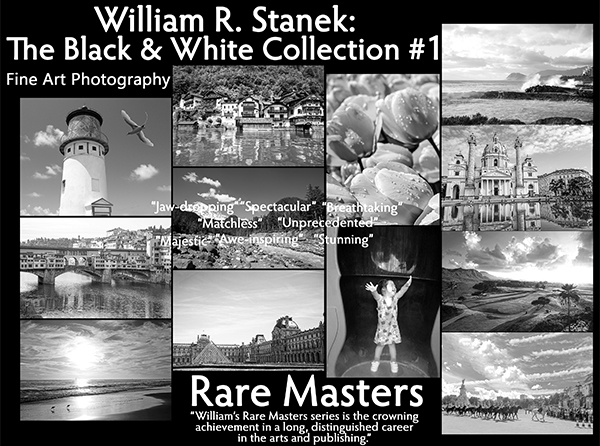
Step into a world of timeless beauty with our premium, oversized hardcover book - crafted for discerning collectors and anyone who values the power of art. Perfect for your coffee table, it's more than just a book; it's a conversation starter, a window into over 30 years of William's visionary photography.
Your Support Matters
Purchasing artwork from William Stanek's collection not only brings beauty into your life but also helps us continue to share. Thank you for supporting our creative journey!

Support The Lights of Paris by Robert Stanek, William Stanek's pen name! Through vivid historical detail and deeply moving character stories, Robert takes readers on an unforgettable journey through one of history’s most transformative times.



